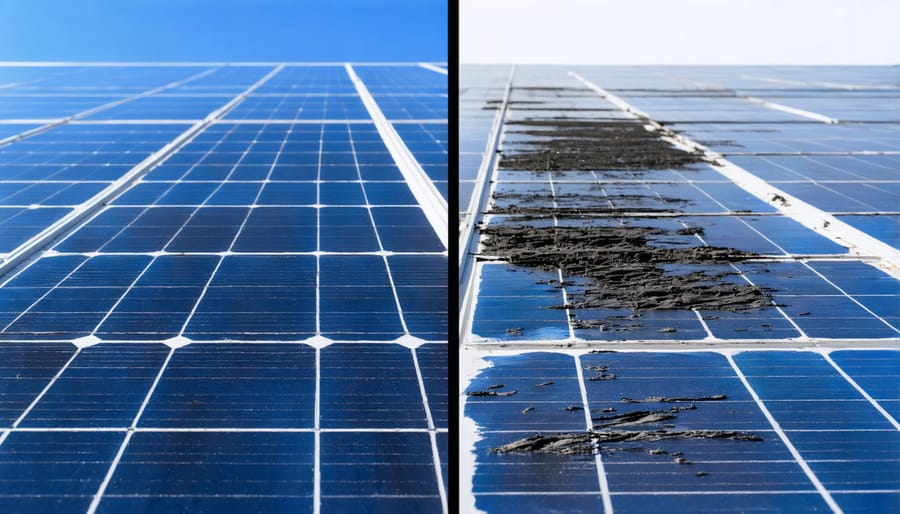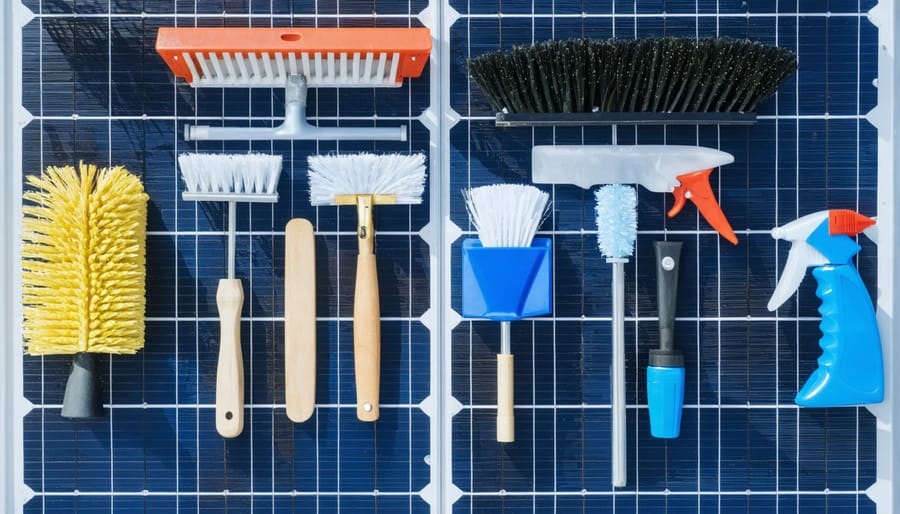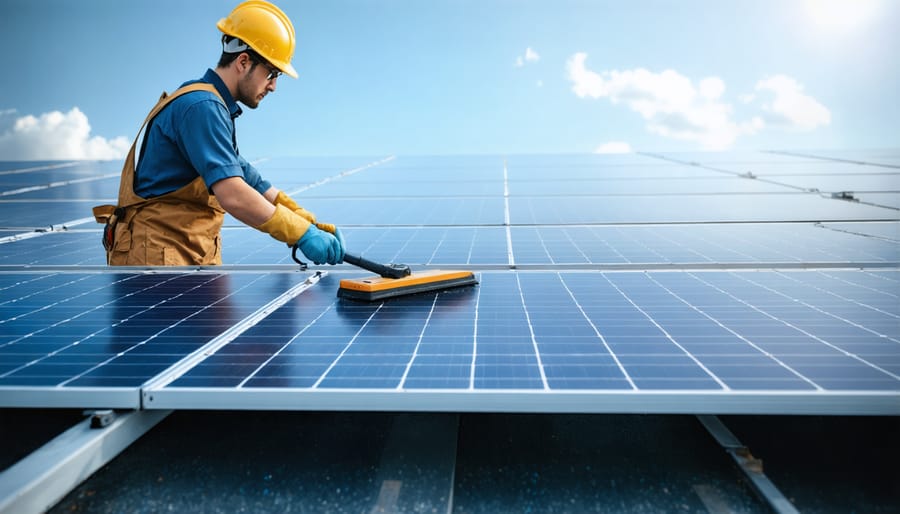Keep Your Solar Panels Spotless: DIY Cleaning That Actually Works

Keep your solar investment performing at peak efficiency with professional-grade cleaning techniques you can safely execute at home. Regular solar panel maintenance boosts energy production by up to 30%, making DIY cleaning a crucial skill for system owners.
Clean panels during early morning or evening hours when surfaces are cool and safe to touch. Use a soft-bristled brush attached to an extendable pole, combined with deionized water and a gentle, non-abrasive biodegradable soap specifically formulated for solar equipment. Remove accumulated dirt, leaves, and bird droppings that can create hotspots and reduce efficiency.
Monitor weather patterns and schedule cleanings after extended dry periods when dust accumulation peaks. For optimal results, maintain a quarterly cleaning schedule, adjusting frequency based on local environmental conditions and pollution levels. Ground-mounted systems require particular attention to prevent vegetation overgrowth and debris accumulation along lower edges.
Always prioritize safety by using proper fall protection equipment when accessing roof-mounted panels, and consider professional assistance for systems installed at challenging angles or heights beyond safe reach.
Why Regular Solar Panel Cleaning Matters
The Real Cost of Dirty Panels
Research shows that dirty solar panels can significantly reduce your system’s energy output, impacting both environmental benefits and financial returns. Studies conducted across European regions indicate that soiled panels typically experience a 5-10% reduction in efficiency, with some cases showing losses up to 25% in particularly dusty or polluted areas.
In monetary terms, this translates to substantial annual losses. For a typical 4kW residential system in Europe, a 5% reduction in efficiency could mean losing €150-200 in potential energy generation annually. During extended dry periods or in areas with high pollution levels, these losses can escalate dramatically.
Regular cleaning is essential to maximize solar panel performance. Data from the European Solar Association reveals that panels cleaned at least twice yearly maintain 95-98% of their optimal efficiency, compared to uncleaned panels that may drop below 85% efficiency after just one year. This difference becomes particularly notable during peak production months, when every percentage point of efficiency directly impacts your energy generation and cost savings.

Safety First: Before You Start
Before undertaking any solar panel cleaning, it’s crucial to familiarize yourself with proper solar panel safety guidelines to ensure both your safety and the protection of your investment. Always check weather conditions before starting – avoid cleaning during intense sunlight or strong winds. Early morning or cloudy days are ideal, as panels are cooler and there’s less risk of thermal shock from cold water on hot surfaces.
Ensure you have a secure access point to your roof and proper fall protection equipment if working at height. Never attempt cleaning if your roof is steep or if you’re unsure about safe access. If your panels are ground-mounted, establish a stable working area around them.
Wear appropriate personal protective equipment, including non-slip shoes, safety glasses, and gloves resistant to cleaning solutions. Inspect your panels for any visible damage, exposed wiring, or loose connections before starting. If you notice any issues, contact a professional immediately.
Remember to disconnect the system following manufacturer guidelines if required, and never use metal tools or abrasive materials that could damage the panels.
Essential Cleaning Tools and Materials
What You Need
To effectively clean your solar panels, you’ll need a combination of basic cleaning tools and safety equipment. Start with a soft-bristled brush or mop with an extendable handle, which allows you to reach panels safely from the ground. For the cleaning solution, prepare a bucket of warm water – avoid using harsh chemicals or abrasive cleaners as these can damage the panels’ protective coating.
Essential items include:
– Soft microfibre cloth or sponge
– Squeegee with rubber blade
– Garden hose with adjustable nozzle
– Non-abrasive biodegradable soap (if needed)
– Bucket
– Distilled water (for final rinse)
For safety, ensure you have:
– Non-slip shoes
– Safety harness (if working at height)
– Safety glasses
– Rubber gloves
– Sturdy ladder (if required)
Additional helpful items:
– Water-fed pole system
– Leaf blower (for removing loose debris)
– Soft brush attachment
– pH-neutral cleaning solution specifically designed for solar panels
Keep these materials easily accessible and maintain them in good condition for regular cleaning sessions. Remember to check your equipment before each use to ensure everything is in proper working order.

What to Avoid
To protect your solar panels’ efficiency and longevity, avoid using certain cleaning materials that could cause damage. Never use abrasive cleaners, steel wool, or scouring pads, as these can scratch the protective glass surface and reduce energy production. Harsh chemicals, including bleach, ammonia-based products, and strong detergents, can deteriorate the panel’s protective coating and potentially void your warranty.
Avoid using hard water for cleaning, as it can leave mineral deposits that create spots and reduce panel efficiency. Similarly, stay away from pressure washers, as the high-pressure stream can damage the seals around your panels and potentially cause water infiltration.
Metal or sharp-edged tools should never be used to remove debris, as they can scratch or crack the panels. Hot water is also unsuitable, as sudden temperature changes could cause thermal stress and damage the glass. Additionally, avoid cleaning solutions containing vinegar or other acidic substances, which can corrode the metal components of your solar installation.
Remember that inappropriate cleaning methods can lead to permanent damage and reduced energy output, potentially resulting in costly repairs or replacements.
Step-by-Step Cleaning Process
Initial Inspection
Before starting any cleaning procedure, conduct a thorough visual inspection of your solar panels to ensure safe and effective cleaning. Begin by examining the panels from ground level using binoculars to identify visible dirt, debris, or potential damage. Look for bird droppings, fallen leaves, dust accumulation, and any obvious stains or discolouration.
Check the panels’ mounting system and surrounding area for signs of loose fixtures or structural issues. Note any cracks, chips, or damaged areas that might require professional attention. These damaged areas should be avoided during cleaning to prevent water infiltration.
Assess the panels’ accessibility and identify potential hazards such as loose tiles or unstable surfaces. Consider the weather conditions – avoid inspection during rain, strong winds, or extreme temperatures. If your panels are equipped with monitoring systems, review recent performance data to understand how soiling might be affecting efficiency.
Document any findings and take photographs if possible. This documentation helps track panel condition over time and can be valuable for warranty claims or professional consultations if needed.
The Cleaning Method
Start by gathering your cleaning supplies: a soft-bristled brush or sponge, a bucket of demineralised water, mild soap (if needed), and a squeegee with a long extension handle. Ensure you’re working during the early morning or late evening when panels are cool to prevent thermal shock.
Before beginning, switch off your solar system following your manufacturer’s guidelines. This safety measure is crucial for both you and your equipment. Inspect the panels from ground level for any visible damage or areas requiring special attention.
First, remove loose debris by gently spraying the panels with a garden hose from ground level. The water pressure should be moderate – similar to heavy rainfall. Avoid using high-pressure washers as these can damage the panels’ protective coating.
If your panels require more thorough cleaning, mix a small amount of mild, non-abrasive soap with demineralised water. Using your soft brush or sponge attached to the extension handle, apply the solution in gentle circular motions. Work systematically from the top of each panel downwards to prevent dirty water from running over already cleaned areas.
For stubborn spots, such as bird droppings or tree sap, allow the cleaning solution to sit for a few minutes before gently scrubbing. Never use abrasive materials or harsh chemicals, as these can scratch or damage the panel surface.
Rinse thoroughly with clean demineralised water to remove all soap residue. Use your squeegee to remove excess water, working in straight lines from top to bottom. This helps prevent water spots from forming as the panels dry.
Finally, allow the panels to air dry completely before switching the system back on. While cleaning, continuously monitor your footing and maintain a safe distance from the edge of your roof. If you’re unsure about any aspect of the cleaning process, consider consulting a professional maintenance service.
Remember to document your cleaning schedule and any observations about panel condition for future reference. Regular cleaning every 3-6 months helps maintain optimal system performance throughout the year.

Post-Cleaning Care
After cleaning your solar panels, inspect them thoroughly to ensure no soap residue or streaks remain, as these can affect energy production. For optimal performance, maintain a regular cleaning schedule based on your local environment – typically every 3-4 months in most European regions, or more frequently in areas with high pollution or bird activity.
Monitor your system’s performance through your inverter readings or monitoring app for several days following cleaning. A noticeable increase in energy production indicates successful cleaning, while unchanged or decreased output might suggest the need for professional inspection.
Keep detailed records of your cleaning sessions, noting the date, methods used, and any observations about panel condition. This documentation helps establish effective maintenance patterns and identifies potential issues early.
Consider applying a protective nano-coating after professional cleaning to reduce dirt accumulation and make future cleaning easier. These treatments typically last 2-3 years and can significantly reduce maintenance frequency while maintaining optimal energy production.
Remember to check weather forecasts before cleaning and avoid cleaning during peak sunshine hours to prevent rapid water evaporation and potential mineral deposits.
Maintenance Schedule and Tips
To maintain optimal performance of your solar panels, establishing a regular maintenance schedule is essential. For residential installations in European climates, aim to clean your panels every three to four months, with additional checks during pollen season and after significant weather events.
Schedule your cleaning sessions during early morning or evening hours when panels are cool and inactive. This timing not only ensures safer working conditions but also prevents thermal shock to the panels from cold water on hot surfaces.
Create a calendar reminder for:
– Weekly visual inspections from ground level
– Monthly debris removal (leaves, bird droppings)
– Quarterly thorough cleaning sessions
– Bi-annual professional inspections
During autumn, increase cleaning frequency to prevent leaves and debris accumulation. In spring, pay special attention to pollen deposits that can significantly impact efficiency. For coastal areas, consider monthly cleaning due to salt spray accumulation.
Document each cleaning session, noting:
– Date and time of cleaning
– Weather conditions
– Type of cleaning performed
– Any damage or concerns observed
– Performance readings before and after cleaning
Monitor your system’s output through its monitoring system. A sudden drop in efficiency between scheduled cleanings might indicate the need for an additional cleaning session. Remember that in regions with regular rainfall, you might need fewer manual cleaning sessions, but regular inspections remain crucial for maintaining optimal performance.
Maintaining clean solar panels is crucial for maximising your renewable energy investment and ensuring optimal system performance. Throughout this guide, we’ve explored the essential aspects of DIY solar panel cleaning, from gathering the right tools to executing safe and effective cleaning techniques. Regular maintenance not only enhances energy production but also extends the lifespan of your solar installation.
Remember to prioritise safety by choosing appropriate weather conditions, using proper equipment, and following recommended cleaning intervals. While DIY cleaning can save costs, it’s important to recognise when professional assistance might be necessary, particularly for complex installations or hard-to-reach panels.
By implementing these cleaning practices, European homeowners can contribute to sustainable energy production while protecting their investment. Regular monitoring, combined with proper cleaning techniques, ensures your solar panels operate at peak efficiency throughout the year. As we move towards a greener future, maintaining our solar installations becomes increasingly important in achieving our renewable energy goals and reducing our carbon footprint.
Make cleaning your solar panels a regular part of your home maintenance routine, and you’ll enjoy the benefits of optimised solar energy production for years to come.
Leave a Reply